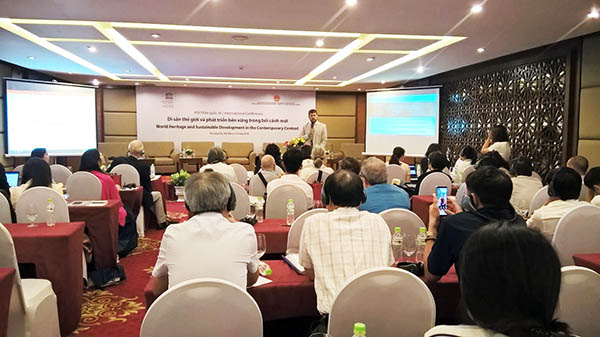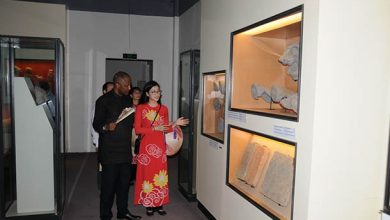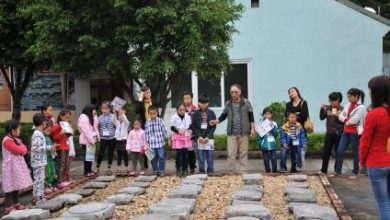International Conference “World Heritage and Sustainable Development in the Contemporary Context”: Awareness of and Direction for Heritage
The International Conference “World Heritage and Sustainable Development in the Contemporary Context” held by the Ministry of Culture, Sports and Tourism in coordination with UNESCO Office in Hà Nội and the People’s Committee of Quảng Ninh took place from 9/7 to 11/7/2018 in Hạ Long.

Mr. Michael Croft – Head of UNESCO Office in Hà Nội addressing the Conference.
The conference attracted the participation of nearly 100 delegates from various departments, ministries, National Council on Cultural Heritage; leaders of the provincial people’s committee and management boards of World Heritage sites and elements in Vietnam, international organizations, diplomatic corps, leading experts in Vietnam and abroad as well as the representatives of the private sector.
According to the structure of the conference, participants attended three official sessions under the following themes: “Public-Private Partnership in World Heritage”, “Heritage and the benefits to the local communities” and “Policy framework and mechanisms to strengthen the conservation of heritage and promotion of sustainable development”. These sessions provided inputs for participants to examine and assess the current situations of World Heritage Sites in Vietnam before making recommendations with regard to the conservation and promotion of these sites while defining the role and contribution of world heritage to sustainable development in Vietnam as well as the Framework for the Implementation of the United Nations’ 2030 Agenda and the Sustainable Development Target Framework of Vietnam, demonstrating the country’s commitment and contribution to the global community as it embarks on more profound international integration.
How to make Public-Private Partnership (PPP) effective
As Vietnam becomes now a middle-income country, policy makers and managers of heritage sites are facing both new opportunities and challenges, including the growing presence and participation of the private sector in the heritage sites. Heritage needs the private sector’s participation for investment in tourism development and heritage conservation.
Examples from Hạ Long, Phong Nha Kẻ Bàng, Tràng An, Huế have testified to the necessity and effectiveness of public-private cooperation in heritage-based tourism development. An undeniable fact is that investment in infrastructure from the private sector through what is termed ‘socialization’ has contributed to an enhanced capacity of the heritage site in meeting the increasingly diverse needs of the sightseeing public. Representatives of all the heritage sites all concurred that through the PPP model, they have been able to mobilize expertise, build capacity and improve professionalism in tourism services while creating many diverse tourism products for increased visibility of the heritage, attracting more visitors, generating jobs and developing the local economy and the communities.
For example, at the Tràng An tourism complex, a local enterprise called Xuân Trường has invested 17,000 billion VND and created jobs for 10,000 direct local laborers. At Phong Nha Kẻ Bàng, companies have also invested hundreds of billions VND into eco-tourism sites like Động Thiên Đường (Heavenly Grotto) Suối Nước Moọc (Moọc Stream) and Sông Chày (Chày River), hang Tối (Tối Cave), etc. to create appealing products to the visitors. Compared to 2010, the number of visitors to this heritage site has increased by more than 150%, thereby increasing tenfold its revenue from sightseeing and service fees.
However, heritage sites also have to confront threats and challenges under the impact of overheated development. These include the real estate bubble and inappropriate infrastructure development that destroys the natural landscape of the heritage sites. That is not to mention adverse impacts on the environment and the local people and the loss of indigenous values. Overexploitation for economic gains may damage the Outstanding Universal Value of the heritage.
Concerning this issue, a research team headed by Assoc.Prof. Dr. Phạm Trương Hoàng (Dean of Tourism and Hotel Management at the National University of Economics) suggested that “we need to nurture heritage more than exploit it”.
Vice Minister of Culture, Sports and Tourism Đặng Thị Bích Liên also remarked that “PPP is a growing trend in the world. And it’s a right trend. But the State must be the one to take control of and maintain the most essential values of the heritage”.
Policy framework and a mechanism to enhance conservation of heritage and promote sustainable development
Since as early as 2009, the World Heritage Committee has started to consider the correlation between sustainable development and the conservation of world heritage. The world heritage and sustainable development policy aims to align the system of world heritage with the United Nations’ Agenda for Sustainable Development. By 2015, UNESCO’s Policy on the integration of a sustainable development perspective into the processes of the World Heritage Convention had been approved and adopted by General Assembly of State Parties to this Convention.
Addressing the recent 42nd meeting of the World Heritage Committee, UNESCO Director-General Audrey Azoulay also said that today’s heritage is facing multiple threats such as armed conflict, illegal trafficking, rapid urbanization, and climate change. These problems do not only affect internationally recognized sites that have been inscribed on the list.
Therefore, the issues of conservation and sustainable development have been given special attention by the World Heritage Committee, especially at a time when the world is undergoing drastic evolutions where countries are becoming increasingly interdependent.
According to Prof. William Logan, Vietnam has developed a system of national regulations that basically suitable with international commitments and conventions, including the Law on Cultural Heritage amended in 2009 and most recently the Government’s Decree 109/2017/NĐ-CP on the protection and management of World Cultural and Natural Heritage in Vietnam. The Law on Cultural Heritage is scheduled to be reviewed and amended in 2019 after a cycle of 10 years. This is an opportunity to incorporate UNESCO 2015 Policy on World Heritage and Sustainable Development into Vietnam’s legal system.
The national and international policy framework must catch up with the rapid pace of development and the growth in the number of factors taking part in the process of heritage management, especially the increasing role of the private sector in the field of trade and service, normally considered to be the centre of heritage promotion.
Taking part in this session, Dr. Trần Việt Anh, Director of the Thăng Long – Hà Nội Heritage Conservation Centre presented a paper on the Contribution of the Scientific Advisory Council to Thăng Long Imperial Citadel. According to him, the council was established by the municipal authorities in 2007 with 30 members and chaired by a leader of the People’s Committee. Vice chair people of the council are experts from the Vietnam’s Historical Science Association and the National Council on Cultural Heritage. The council brings together leading professionals in the fields of culture, history, archaeology, architecture and consultants who help the city of Hanoi and the Thăng Long – Hà Nội Heritage Conservation Centre with the examination, conservation and promotion of the Thăng Long Imperial Citadel from the first days when the site was excavated to the time when the nomination dossier was developed and now the long-term conservation of the heritage site.

Panelists of Session 3 of the Conference
After providing advisory work and formulating the nomination dossier that led to the successful inscription of the Thăng Long Imperial Citadel on the World Heritage List in 2010, the Scientific Advisory Council has continued to play an important role as a companion of the Centre and the People’s Committee of Hanoi in research, management, conservation and promotion activities at the Thăng Long Imperial Citadel. Eight years after the inscription, the Citadel has gradually fulfilled the Vietnamese Government’s commitments to UNESCO by opening the heritage site to greater number of visitors, expanding community activities, improving the working apparatus, building capacity and expertise to meet the requirements of managing the site in the new conditions, formulating legal corridors and devising tools for sustainable management of the heritage through approval of management plans; enhancing cooperation between foreign and Vietnamese counterparts, promoting in-depth research on various conservation fields, expanding archaeological studies as well as stepping up the communications of the heritage site, directed straightly at the visitors and young people
The conference also discussed issues related to heritage and its benefits to the local communities. Linking heritage to community, directing heritage at the service of the community is a good way to address the need for today’s sustainable heritage conservation and promotion.
Kim Yến





